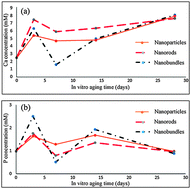Influence of morphology on the in vitro bioactivity of hydroxyapatite nanostructures prepared by precipitation method
Abstract
It seems that the available studies about the effect of morphology on the bioactivity of pure hydroxyapatite (Ca10(PO4)6(OH)2, HAP) are yet insufficient. For this purpose, a novel morphology-controlled synthesis method to fabricate HAP nanostructures is employed by using different Schiff bases as chelating ligands. The formation mechanism of zero-dimensional (0-D) and one-dimensional (1-D) nanostructures of HAP is also considered. Based on the morphological studies of the final products, it is found that the formation of tetradentate and bidentate ligands leads to the preparation of 0-D and 1-D HAP nanocrystals, respectively. The in vitro bioactivity of the as-produced HAP nanostructures is evaluated by soaking the products in simulated body fluid (SBF). The analytical measurements indicate that the changes in the Ca and P concentrations of the 1-D HAP nanostructures are more than those of the 0-D HAP nanostructures, indicating good bioactivity of the nanorods and nanobundles. The formation of new apatite crystals on the surfaces of the HAP nanostructures soaked in the SBF solutions is proved by field emission scanning electron microscopy (FESEM) and diffuse reflectance Fourier transform infrared spectrometry (ATR-FTIR).


 Please wait while we load your content...
Please wait while we load your content...